Evaluation of the Most Stressful Dental Treatment Procedures of Conservative Dentistry among Polish Dental Students
Abstract
:1. Introduction
2. Material and Methods
2.1. Experiment Setup
2.2. Statistical Analysis
3. Results
3.1. Reliability of the Scale
3.2. Category I (Diagnosis)
3.3. Category II (Caries Treatment)
3.4. Category III (Endodontic Treatment)
4. Discussion
5. Limitation of the Study
6. Conclusions
7. Practical Application
Supplementary Materials
Author Contributions
Funding
Institutional Review Board Statement
Informed Consent Statement
Data Availability Statement
Acknowledgments
Conflicts of Interest
References
- Halboub, E.; Alhajj, M.N.; AlKhairat, A.M.; Sahaqi, A.A.M.; Quadri, M.F.A. Perceived Stress among Undergraduate Dental Students in Relation to Gender, Clinical Training and Academic Performance. Acta Stomatol. Croat. 2018, 52, 37–45. [Google Scholar] [CrossRef]
- Mocny-Pachońska, K.; Doniec, R.; Trzcionka, A.; Pachoński, M.; Piaseczna, N.; Sieciński, S.; Osadcha, O.; Łanowy, P.; Tanasiewicz, M. Evaluating the stress-response of dental students to the dental school environment. PeerJ 2020, 8, e8981. [Google Scholar] [CrossRef]
- Mocny-Pachońska, K.; Trzcionka, A.; Doniec, R.J.; Sieciński, S.; Tanasiewicz, M. The Influence of Gender and Year of Study on Stress Levels and Coping Strategies among Polish Dental. Medicina 2020, 56, 531. [Google Scholar] [CrossRef]
- Saddki, N.; Sukerman, N.; Mohamad, D. Association between Emotional Intelligence and Perceived Stress in Undergraduate Dental Students. Malays. J. Med. Sci. 2017, 24, 59–68. [Google Scholar] [CrossRef] [PubMed]
- Jowkar, Z.; Masoumi, M.; Mahmoodian, H. Psychological Stress and Stressors Among Clinical Dental Students at Shiraz School of Dentistry, Iran. Adv. Med. Educ. Pract. 2020, 11, 113–120. [Google Scholar] [CrossRef] [PubMed] [Green Version]
- Basudan, S.; Binanzan, N.; Alhassan, A. Depression, anxiety and stress in dental students. Int. J. Med. Educ. 2017, 8, 179–186. [Google Scholar] [CrossRef] [PubMed] [Green Version]
- Mirza, M.B. Difficulties Encountered during Transition from Preclinical to Clinical Endodontics among Salman bin Abdul Aziz University Dental Students. J. Int. Oral Health 2015, 7, 22–27. [Google Scholar]
- Frese, C.; Wolff, D.; Saure, D.; Staehle, H.J.; Schulte, A. Psychosocial impact, perceived stress and learning effect in undergraduate dental students during transition from pre-clinical to clinical education. Eur. J. Dent. Educ. 2018, 22, e555–e563. [Google Scholar] [CrossRef]
- Rashid, E. Operative Dentistry. In Woelfel’s Dental Anatomy: Its Relevance to Dentistry; Scheid, R., Woelfel, J., Eds.; Point (Lippincott Williams and Wilkins) Series; Lippincott Williams & Wilkins: Philadelphia, PA, USA, 2007; pp. 432–465. [Google Scholar]
- Sathyanarayanan, R.; Carounnanidy, U. Classification and management of dental caries. New concepts. Indian J. Dent. Res. 2002, 13, 21–25. [Google Scholar]
- Medical University of Silesia. Dziekanat Wydziału Nauk Medycznych w Zabrzu—Efekty Kształcenia. Available online: https://student.sum.edu.pl/dziekanat-wydzialu-lekarskiego-z-oddzialem-lekarsko-dentystycznym-w-zabrzu/#efekty-ksztacenia (accessed on 11 April 2021). (In Polish).
- Tanalp, J.; Güven, E.P.; Oktay, I. Evaluation of dental students’ perception and self-confidence levels regarding endodontic treatment. Eur. J. Dent. 2013, 7, 218–224. [Google Scholar] [CrossRef]
- Honey, J.; Lynch, C.D.; Burke, F.M.; Gilmour, A.S.M. Ready for practice? A study of confidence levels of final year dental students at Cardiff University and University College Cork. Eur. J. Dent. Educ. 2011, 15, 98–103. [Google Scholar] [CrossRef]
- Chevalier, V.; Bonnabesse, A.L.F.; Duncan, H.F. Frightened of the pulp? A qualitative analysis of undergraduate student confidence and stress during the management of deep caries and the exposed pulp. Int. Endod. J. 2020, 54, 130–146. [Google Scholar] [CrossRef]
- Hanafi, A.; Donnermeyer, D.; Schäfer, E.; Bürklein, S. Perception of a modular 3D print model in undergraduate endodontic education. Int. Endod. J. 2020, 53, 1007–1016. [Google Scholar] [CrossRef] [Green Version]
- Umoren, R.A.; Sawyer, T.L.; Ades, A.; DeMeo, S.; Foglia, E.E.; Glass, K.; Gray, M.M.; Barry, J.; Johnston, L.; Jung, P.; et al. Team Stress and Adverse Events during Neonatal Tracheal Intubations: A Report from NEAR4NEOS. Am. J. Perinatol. 2019, 37, 1417–1424. [Google Scholar] [CrossRef]
- Terwee, C.B.; Bot, S.D.; de Boer, M.R.; van der Windt, D.A.; Knol, D.L.; Dekker, J.; Bouter, L.M.; de Vet, H.C. Quality criteria were proposed for measurement properties of health status questionnaires. J. Clin. Epidemiol. 2007, 60, 34–42. [Google Scholar] [CrossRef] [PubMed] [Green Version]
- Erden, A.P.; Peker, K.; Kuru, S.; Sepet, E. Evaluation of Final-Year Turkish Dental Students’ Knowledge, Attitude, and Self-Perceived Competency towards Preventive Dentistry. BioMed Res. Int. 2019, 2019, 1–11. [Google Scholar] [CrossRef] [Green Version]
- Tavares, L.G.; Lima, S.M.F.; Lima, M.G.; Arruda, M.P.; Menegazzi, T.C.; Rezende, T.M.B. Undergraduate dentistry students’ perception of difficulties regarding endodontic treatment. Aust. Endod. J. 2018, 45, 98–105. [Google Scholar] [CrossRef] [Green Version]
- Alrahabi, M. The confidence of undergraduate dental students in Saudi Arabia in performing endodontic treatment. Eur. J. Dent. 2017, 11, 17–21. [Google Scholar] [CrossRef] [PubMed]
- Murray, C.M.; Chandler, N.P. Undergraduate endodontic teaching in New Zealand: Students’ experience, perceptions and self-confidence levels. Aust. Endod. J. 2014, 40, 116–122. [Google Scholar] [CrossRef]
- Chandrasekaran, B.; Cugati, N.; Kumaresan, R. Dental Students’ Perception and Anxiety Levels during their First Local Anesthetic Injection. Malays. J. Med. Sci. MJMS 2014, 21, 45–51. [Google Scholar]
- Qualtrough, A.J.E. Undergraduate endodontic education: What are the challenges? Br. Dent. J. 2014, 216, 361–364. [Google Scholar] [CrossRef] [PubMed]
- Hattar, S.; AlHadidi, A.; Altarawneh, S.; Hamdan, A.A.S.; Shaini, F.J.; Wahab, F.K. Dental students’ experience and perceived confidence level in different restorative procedures. Eur. J. Dent. Educ. 2020, 25, 207–214. [Google Scholar] [CrossRef] [PubMed]
- Rajan, S.; Chen, H.Y.; Chen, J.J.; Chin-You, S.; Chee, S.; Chrun, R.; Byun, J.; Abuzar, M. Final year dental students’ self-assessed confidence in general dentistry. Eur. J. Dent. Educ. 2020, 24, 233–242. [Google Scholar] [CrossRef] [PubMed]
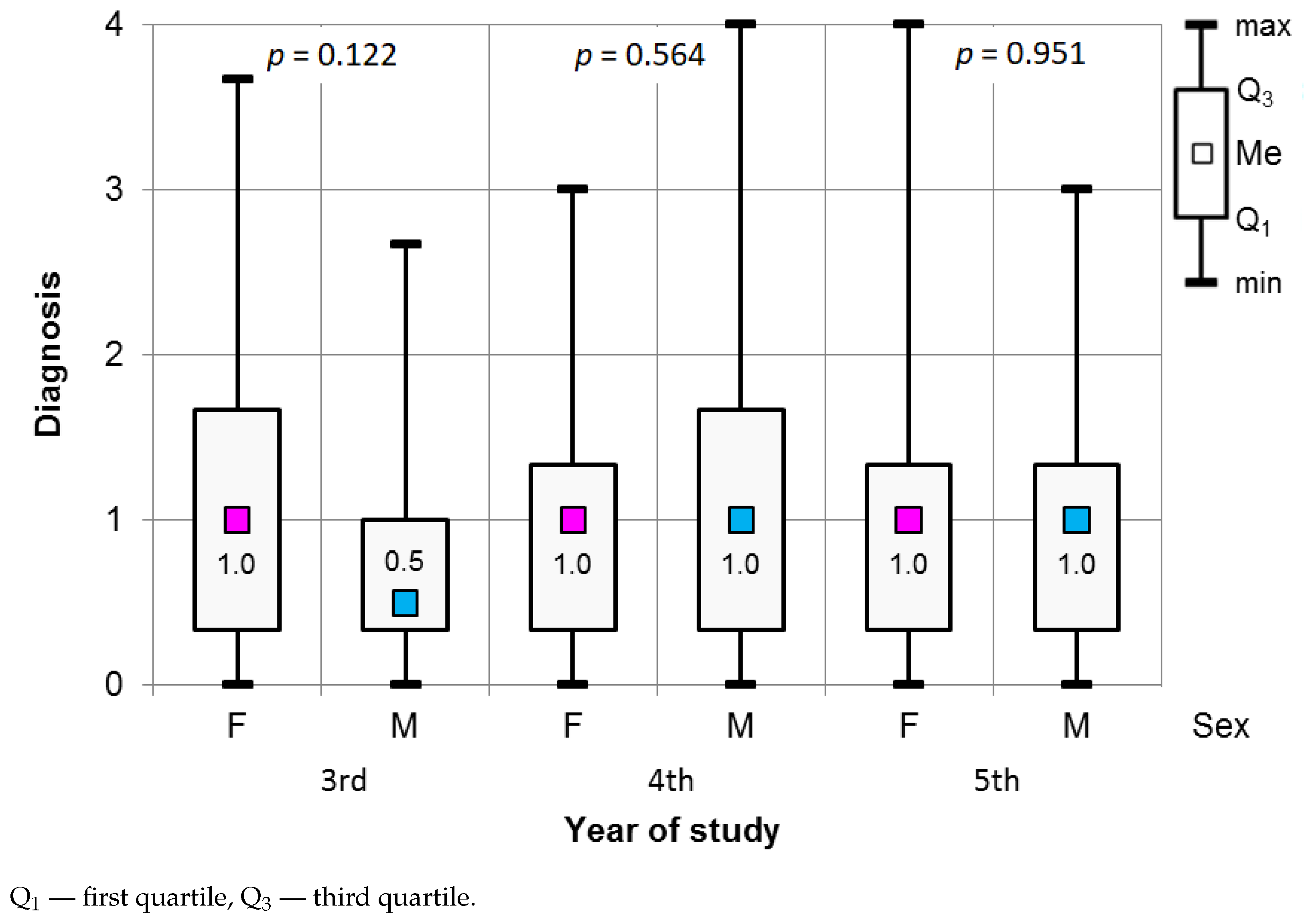
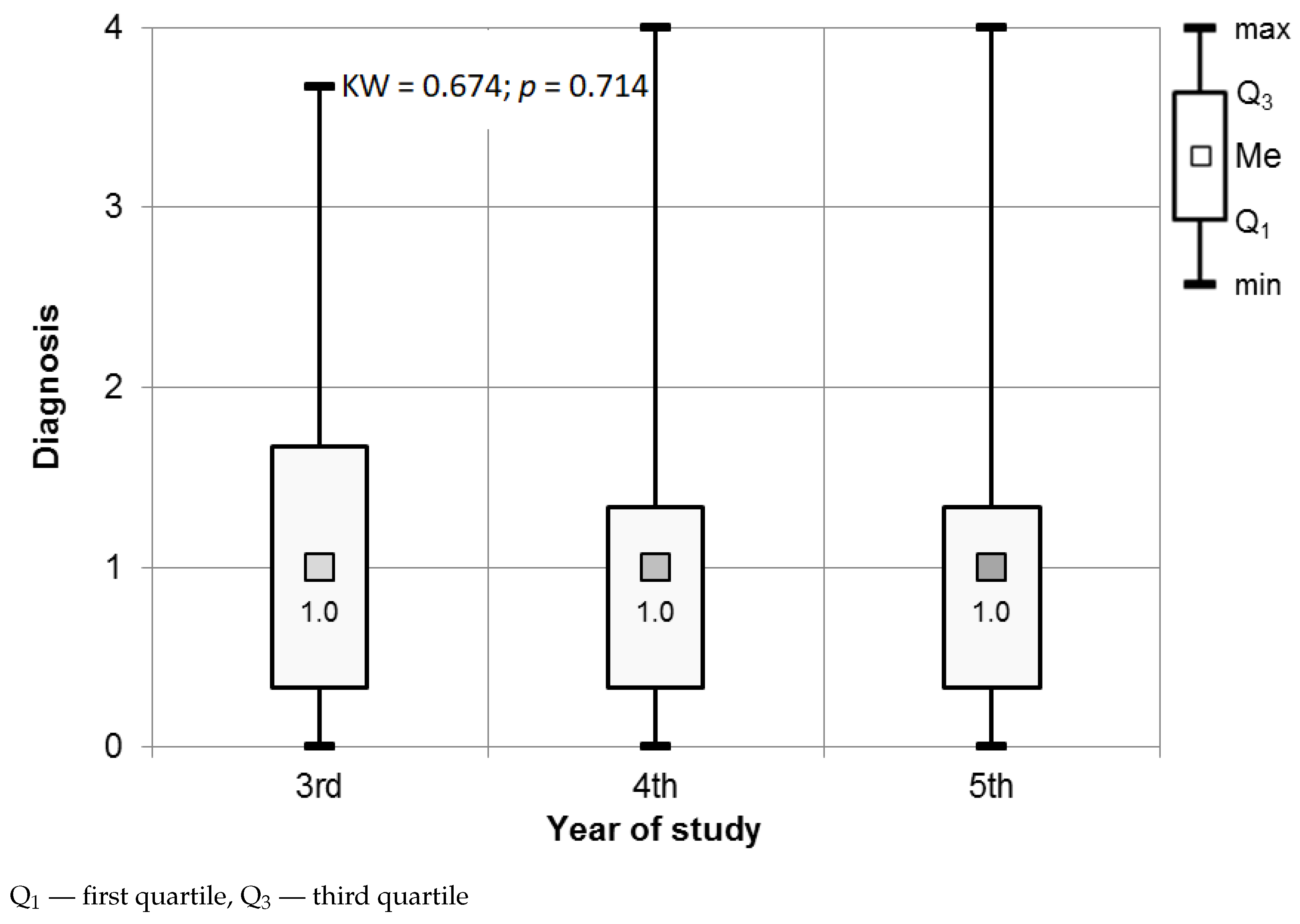
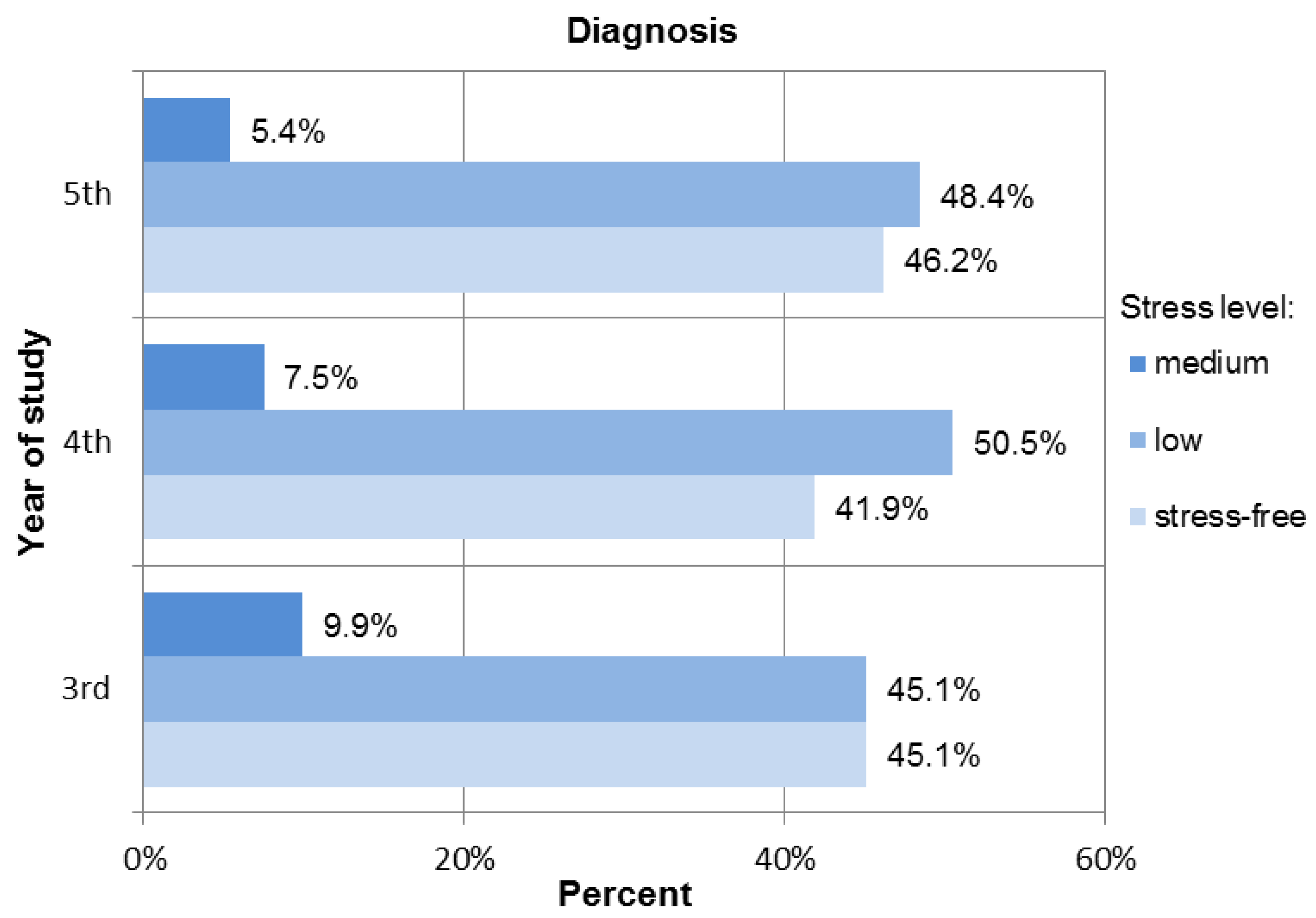

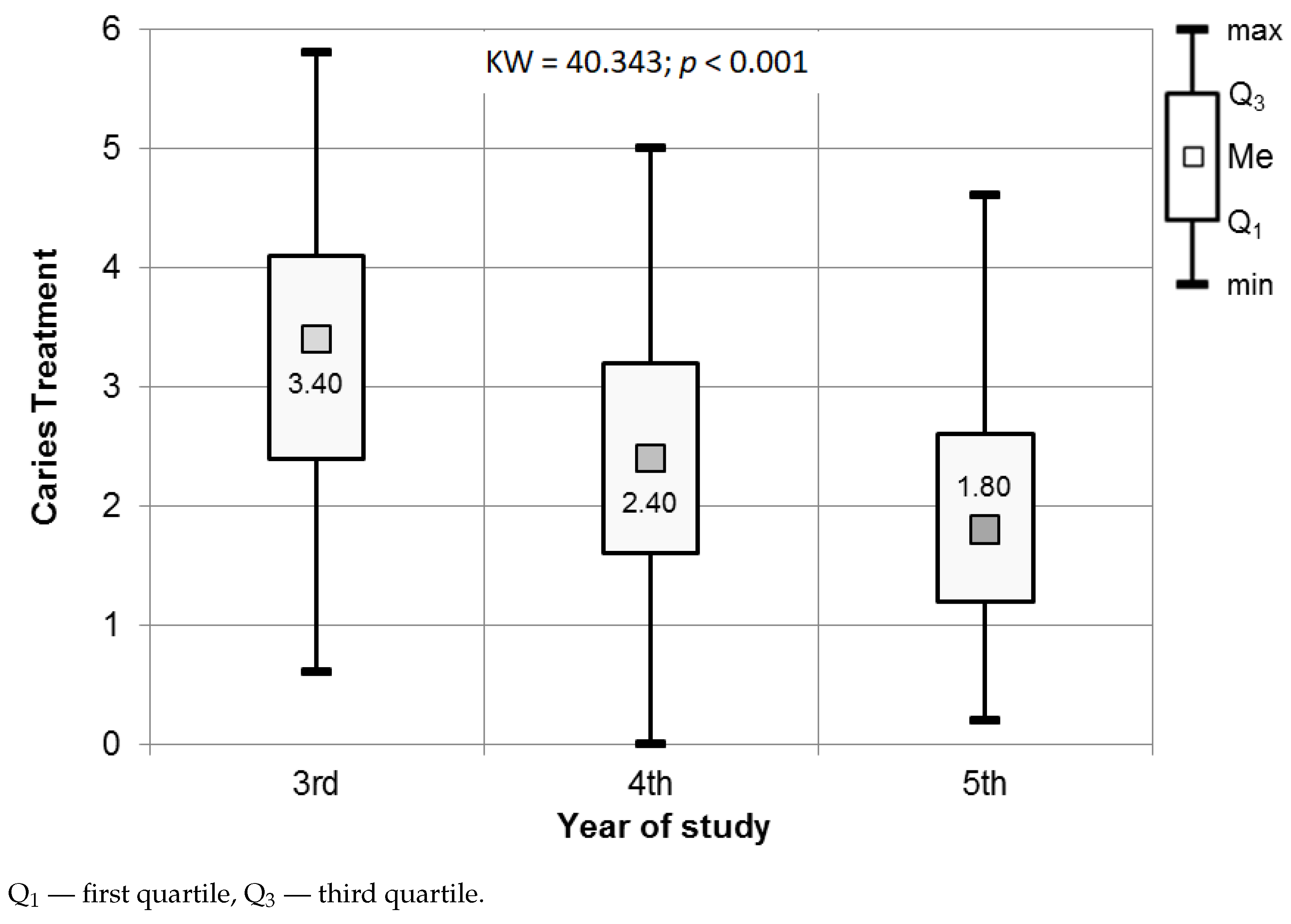
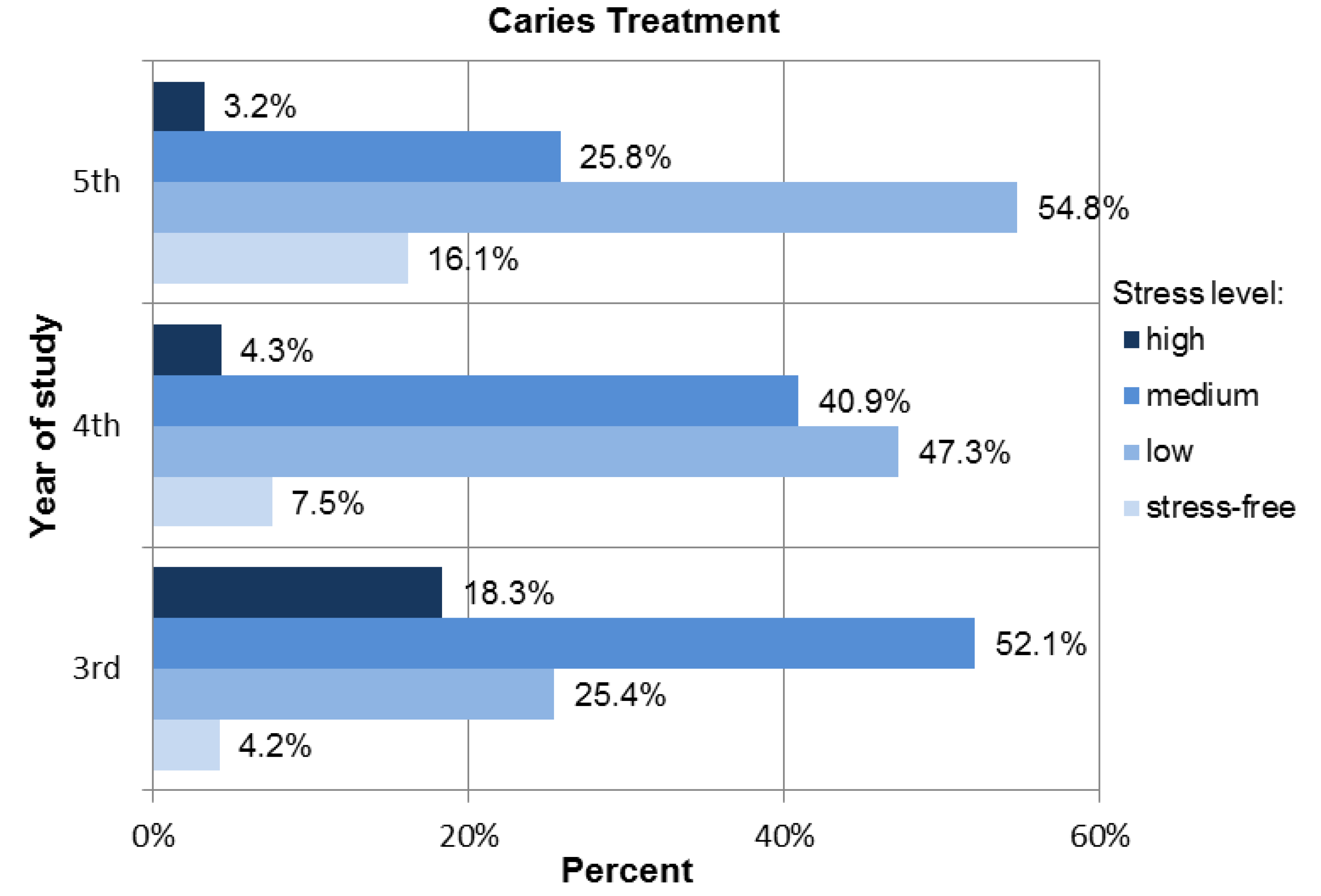


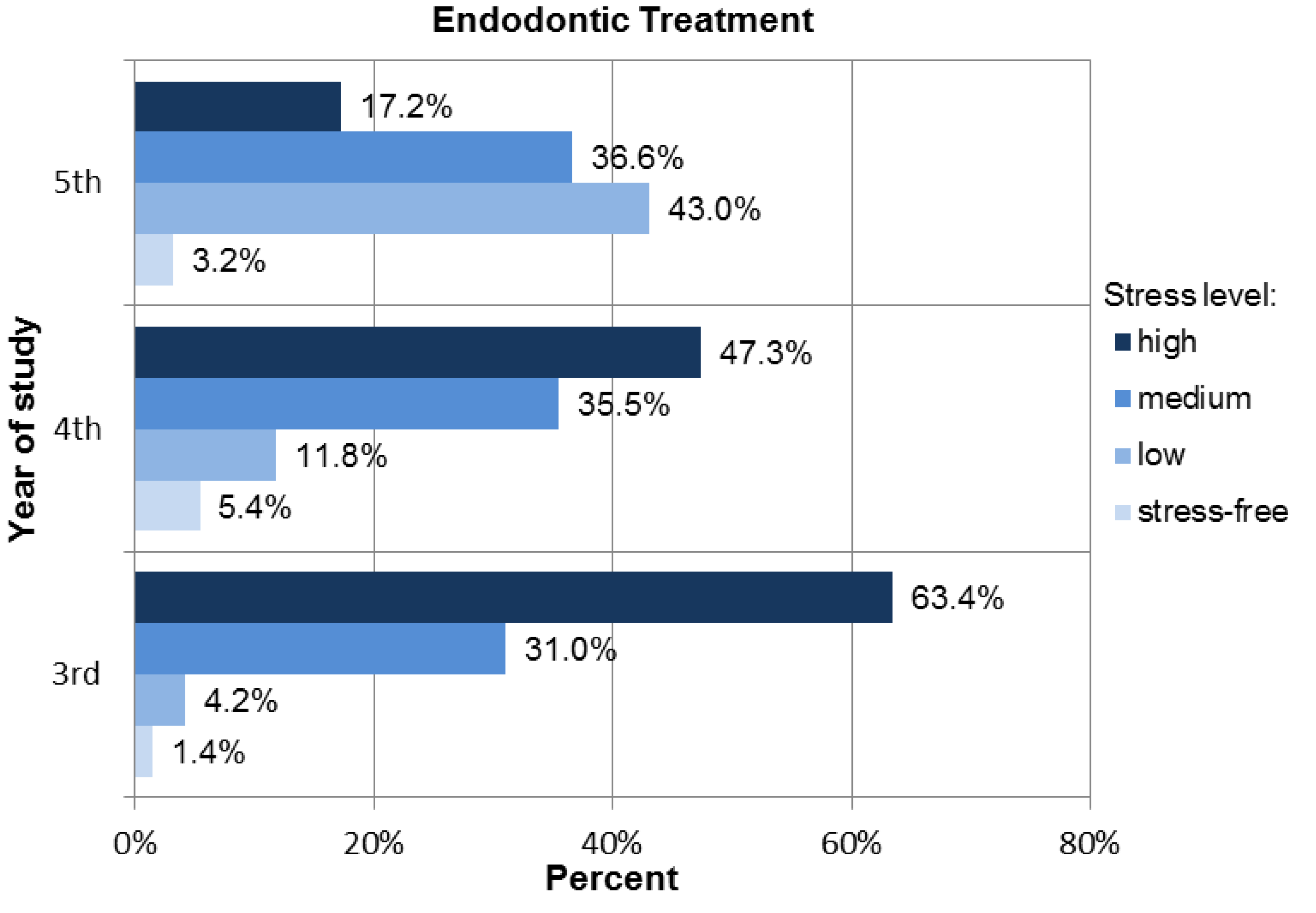
| Year of Study | Number of Students | Median Age [Years] |
|---|---|---|
| Third | 71 | 23 |
| (53 women, 18 men) | ||
| Fourth | 93 | 24 |
| (58 women, 35 men) | ||
| Fifth | 93 | 24 |
| (68 women, 25 men) |
| Survey | Item Elimination | |||||
|---|---|---|---|---|---|---|
| Group | Item | |||||
| I (Diagnosis) | Total | 0.75 | 0.80 | 0.56 | 3 | 0.76 |
| Female | 0.73 | 0.77 | 0.53 | 3 | 0.74 | |
| Male | 0.80 | 0.84 | 0.64 | 3 | 0.81 | |
| II (Caries Treatment) | Total | 0.82 | 0.81 | 0.47 | - | - |
| Female | 0.81 | 0.80 | 0.45 | - | - | |
| Male | 0.82 | 0.82 | 0.45 | - | - | |
| III (Endodontic Treatment) | Total | 0.89 | 0.89 | 0.59 | 6 | 0.91 |
| Female | 0.89 | 0.90 | 0.60 | 6 | 0.91 | |
| All | 0.88 | 0.89 | 0.57 | 6 | 0.90 | |
| Dunn–Bonferroni | ||||
|---|---|---|---|---|
| Conover | Year of study | Third | Fourth | Fifth |
| Third | <0.001 | <0.001 | ||
| Fourth | 0.05 | 0.03 | ||
| Fifth | 0.02 | NS | ||
| Dunn-Bonferroni | ||||
|---|---|---|---|---|
| Conover | Year of study | Third | Fourth | Fifth |
| Third | 0.04 | <0.001 | ||
| Fourth | NS | <0.001 | ||
| Fifth | 0.02 | 0.04 | ||
Publisher’s Note: MDPI stays neutral with regard to jurisdictional claims in published maps and institutional affiliations. |
© 2021 by the authors. Licensee MDPI, Basel, Switzerland. This article is an open access article distributed under the terms and conditions of the Creative Commons Attribution (CC BY) license (https://creativecommons.org/licenses/by/4.0/).
Share and Cite
Mocny-Pachońska, K.; Doniec, R.J.; Wójcik, S.; Sieciński, S.; Piaseczna, N.J.; Duraj, K.M.; Tkacz, E.J. Evaluation of the Most Stressful Dental Treatment Procedures of Conservative Dentistry among Polish Dental Students. Int. J. Environ. Res. Public Health 2021, 18, 4448. https://doi.org/10.3390/ijerph18094448
Mocny-Pachońska K, Doniec RJ, Wójcik S, Sieciński S, Piaseczna NJ, Duraj KM, Tkacz EJ. Evaluation of the Most Stressful Dental Treatment Procedures of Conservative Dentistry among Polish Dental Students. International Journal of Environmental Research and Public Health. 2021; 18(9):4448. https://doi.org/10.3390/ijerph18094448
Chicago/Turabian StyleMocny-Pachońska, Katarzyna, Rafał J. Doniec, Sylwia Wójcik, Szymon Sieciński, Natalia J. Piaseczna, Konrad M. Duraj, and Ewaryst J. Tkacz. 2021. "Evaluation of the Most Stressful Dental Treatment Procedures of Conservative Dentistry among Polish Dental Students" International Journal of Environmental Research and Public Health 18, no. 9: 4448. https://doi.org/10.3390/ijerph18094448
APA StyleMocny-Pachońska, K., Doniec, R. J., Wójcik, S., Sieciński, S., Piaseczna, N. J., Duraj, K. M., & Tkacz, E. J. (2021). Evaluation of the Most Stressful Dental Treatment Procedures of Conservative Dentistry among Polish Dental Students. International Journal of Environmental Research and Public Health, 18(9), 4448. https://doi.org/10.3390/ijerph18094448








